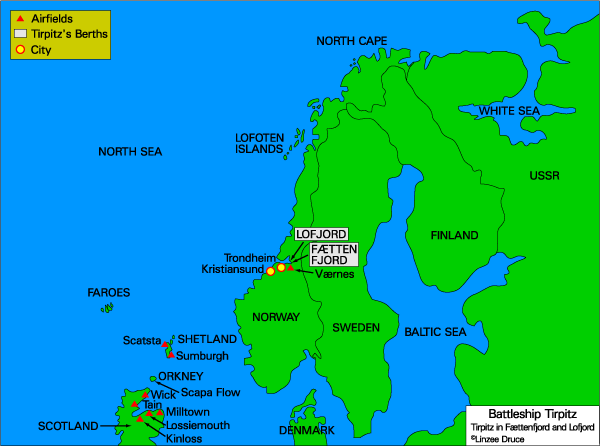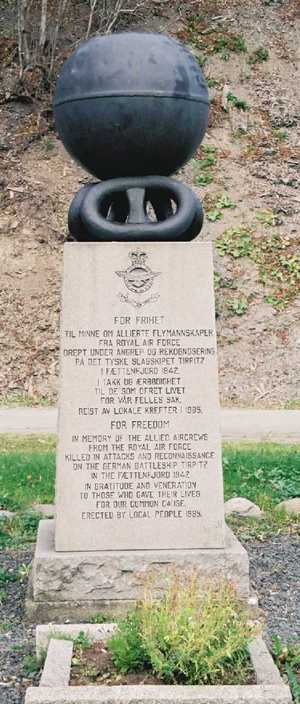Air Raids on Tirpitz - Spring 1942
|
During the three attacks against Tirpitz in the spring of 1942 thirteen aircraft from Bomber Command were lost with the loss of 60 lives. One Coastal Command Beaufighter was lost with the loss of two men and three PRU Spitfires with the loss of two Pilots. A total of 64 RAF airmen lost their lives between January and April 1942 attempting to sink Tirpitz, an objective which was not ultimately achieved until some two years later in November 1944. The Allied Governments and their forces were in no doubt about the threat that such an imposing ship could pose. When Tirpitz sailed to Norway in January 1942, her positioning there was cause for great concern. From Norway she could strike at shipping in the North Sea and the Atlantic. The mere presence of Tirpitz in Norway would ensure that significant numbers of Allied ships were placed in the Atlantic thus preventing them from being used elsewhere, in the Pacific, Indian Ocean or Mediterranean. The British Prime Minister, Winston Churchill, wrote on 25th January 1942, "The destruction or even crippling of this ship is the greatest event at sea at the present time. No other target is comparable to it." Churchill was under no illusions that Tirpitz was a target of utmost importance. The fact that her presence in Norway was tying up almost four times the number of British capital ship in the Atlantic, not to mention the American battleships, had not gone unnoticed. Intelligence gathered by sorties flown by RAF PRU (Photographic Reconnaissance Unit) aircraft and from members of the Norwegian resistance gave the location of the Tirpitz and other German ships in the fjords. Tirpitz had sailed up Trondheimfjord into Åsenfjord and was berthed in a smaller fjord leading off Åsenfjord called Fættenfjord some 15 miles from Trondheim. Fættenfjord is three quarters of a mile wide with steep cliffs on three sides, and Tirpitz was berthed on the north shore of the fjord below a steep cliff. The ship was well camouflaged and was protected from attack by anti-submarine nets and protective booms in the water as well as Anti Aircraft and searchlights positions on the surrounding cliffs. During 1942, there were four attempts made by the RAF to attack and sink the Battleship Tirpitz. The first was on 30/31st January 1942 when Stirling aircraft from 15 and 149 Squadrons, along with Halifaxes from 10 and 76 Squadrons participated in 'Operation Oiled', an attack against the Tirpitz as she lay in Fættenfjord in Norway. Flying from an advanced air base in Scotland (RAF Lossiemouth), seven Stirlings from 15 and 149 Squadrons took off at 0030 hrs. Weather conditions were not good with cloud from sea level to 20,000 feet. One of the Stirlings reported having seen the mast tops of Tirpitz, but was unable to gain sufficient height in order to drop it's bomb load. All the Stirlings returned safely to base. The Halifaxes, four from 10 Squadron and five from 76 Squadron started taking off at 0204 hrs. All four of the 10 Squadron aircraft had to return to base before reaching the target due to lack of fuel. The five 76 Squadron Halifaxes reached the target area, but weather conditions prevented them from locating the target. All aircraft returned to base with the exception of one 76 Squadron Halifax which ditched in the North Sea just off the coast from Aberdeen. The crew were all uninjured and were rescued by the Aberdeen Lifeboat. The second attempt was on the night of 30/31st March 1942, when Halifaxes from 10, 35 and 76 Squadrons made an attack. In April 1942 there were two attacks on consecutive nights made by Halifaxes from 10, 35 and 76 Squadrons, and Lancasters from 44 and 97 Squadrons on the nights of 27/28th April and 28/29th April. |
|
Map showing location of Tirpitz in Norway and air bases in Scotland.
|
 |
 |
Today, less than five hundred meters from where Tirpitz was moored in Fættenfjord, stands a monument erected by the local people in this part of Norway in memory of the allied airmen from the RAF who were killed during operations against Tirpitz.
The monument is made of granite, with three links of the anchor chain from Tirpitz placed on top supporting one of the mines that was dropped by a Halifax aircraft during one of the attacks in the spring of 1942. The inscription on the monument is in both Norwegian and in English and reads as follows: FOR FRIHET Photo: T Eggan |
Back to Top
© Linzee Druce 2001-2012